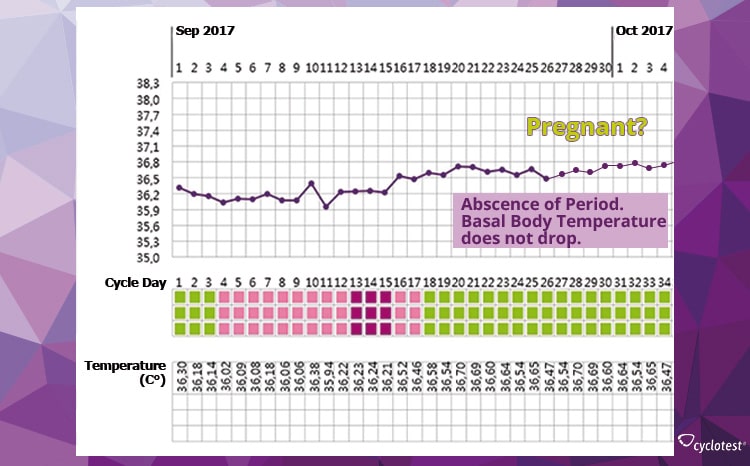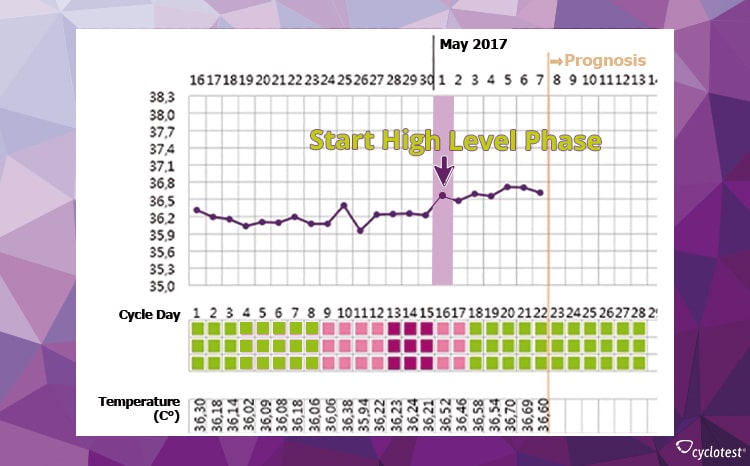Was Du auf dieser Seite findest:
- Basal Body Temperature as Body Signal
- What Regulates the Body’s Temperature?
- How Does the Basal Body Temperature Change?
- What is the Basal Body Temperature Graph?
- Temperature Method – Evaluating the Basal Body Temperature
- How Do I Measure the Basal Body Temperature Correctly?
- Influences on the Basal Body Temperature
Basal Body Temperature as Body Signal
In the menstrual cycle there are multiple ovulation symptoms associated with hormonal changes within a menstrual cycle. One of the most meaningful is the recording and evaluation of the basal body temperature, the so-called temperature method or basal body temperature method.
If you want to have a baby or would like to prevent a pregnancy, a look at your basal body temperature will provide you with important information about your current fertility status. The basal body temperature changes over the course of the day and is subject to a 24-hour rhythm. The temperature is lowest in the early morning hours and highest in the late afternoon.1
In order to obtain comparable measurement results, it is necessary to measure directly after waking up in the morning when applying the temperature method. Therefore, this temperature is also called basal body or waking temperature.
What Regulates the Body’s Temperature?
The hormone progesterone is produced in the second cycle phase after ovulation in the corpus luteum. It has the property of influencing the heat regulation centre of the body and increasing the temperature. Since the sex hormone is only formed when ovulation precedes ovulation, the rise in temperature can be regarded as a sure sign of ovulation.2
How Does the Basal Body Temperature Change?
There are 2 temperature levels within a regular cycle. In the first half of the cycle, the basal body temperature is slightly lower, which is why this phase is also known as the low level phase. 1 to 2 days before the temperature rise, you can often notice a slight drop in temperature. This temperature low is just before ovulation. The waking temperature then rises by at least 0.2 °C in the second half of the cycle by a few tenths of a degree. This second phase, which lasts until the next menstrual period, is called high level phase.1
Basal Body Temperature before Menstruation
If the egg has not been fertilised, the corpus luteum dies 12-16 days after ovulation and the progesterone level decreases. This causes the temperature to drop again shortly before the beginning of menstruation.
Basal Body Temperature During Pregnancy
If you want to get pregnant quickly or at a certain time, the measurement and documentation of the morning waking temperature is an ideal aid. For example, cyclotest myWay shows you the fertile days and the highly fertile time. This small window of time can be precisely determined and the chances of a pregnancy can be increased.
If you continue to measure diligently, you can use the basal body temperature graph to see whether a pregnancy has occurred. If your temperature remains at a higher level for a period of more than 18 days and you have not had a period during this time, you can assume that your desire to have a child has been fulfilled. This long high level period, which is caused by the hormone change during fertilization, is one of the reliable signs of pregnancy. The following figure shows the permanent temperature rise as a curve:

Basal Body Temperature Pregnancy | Image: © cyclotest
What is the Basal Body Temperature Graph?
By daily recording the basal body temperature values in a cycle or curve sheet, the basal body temperature graph is created by connecting the individual points together. This temperature graph is also commonly referred to as a cycle graph. It illustrates the temperature progression in the cycle, which allows conclusions to be drawn about the ovulation date and thus also about the fertile and infertile period.
Our cycle computer cyclotest myWay creates a clear cycle graph for each cycle – supplemented by further relevant information. This compact info inlcuding temperature graphs and other information not only gives you a great overview, but also your gynaecologist can draw valuable conclusions about your cycle. The following graphic shows you an example of a cycle graph from the minicomputer. You can see that the temperature has risen by about 0.3°C from day 15 to day 16 and represents the beginning of the high level phase.

Basal Body Temperature Graph | Image: © cyclotest
Temperature Method – Evaluating the Basal Body Temperature
The evaluation of the basal body temperature is about interpreting the temperature graph with regard to your fertility status. The temperature method is based on the basal body temperature rising after ovulation. With this method, it can be determined afterwards that ovulation has occurred.1 The temperature method is a method of Natural Family Planning (NFP).
Relationship Between Basal Body Temperature and Ovulation
The World Health Organization (WHO) has defined criteria for determining the basal temperature of an ovulation:3
- If ovulation occurs, the temperature will rise within 48 hours or less.
- The basal body temperatures of 3 consecutive days should be at least 0.2 °C higher than in the previous 6 days.
If the temperature level remains the same throughout the cycle (monophasic), ovulation is unlikely to occur.
Advantages of the Temperature Method
The comparison of contraceptive methods shows that the temperature method is considered a natural contraceptive method and therefore offers numerous advantages:
On the one hand, this system has a good contraceptive safety index, the so-called Pearl Index. This is especially important with regard to natural contraception. In addition, this method does not interfere with the natural body processes or cause a rise in hormones, which would be the case, for example, when taking the pill.
In addition, this method expands your knowledge about the processes in the female body. After all, it is easy to learn with a little practice; other body signs, such as the cervix, require intensive study.
Temperature Method for Getting Pregnant
This method of Natural Family Planning is especially recommended to fulfill your desire to have a baby. The basal body temperature method can be used to identify the most important fertile days – on these days you should have sexual intercourse.
In combination with the cervical mucus analysis, you can use the symptothermal method, which combines two symptoms with each other and can thus narrow down the fertile and infertile days even more precisely, in order to fulfill your desire to have children.
What Tools do I Need for the Temperature Method?
You can measure with an analogue thermometer or a digital thermometer with 2 decimal places like the cyclotest lady basal thermometer. The values are rounded to half a tenth of a degree and noted down in a cycle sheet in the form of points. If you connect the dots together, at the end of your cycle you will see the basal body temperature curve that illustrates the increase in your wake-up temperature.
If the manual effort is too much for you, cyclotest myWay is a worthwhile alternative. It records your basal body temperature precisely and reliably – the thermometer is integrated -, evaluates the results individually and saves you the manual entry into a cycle sheet. You can read your fertility status on a daily basis at first glance and your cycle graph is displayed with just one click.
The minicomputer can additionally evaluate a second body sign, for example the result of an ovulation test or the cervical mucus. These also provide information on the fertile cycle phase. Especially in the latter case, the evaluation in combination with the waking temperature is worthwhile if you want to become pregnant or are looking for hormone-free contraception.
How Do I Measure the Basal Body Temperature Correctly?
Measurements should be taken lying in bed, i. e. immediately after waking up before any activity. This is very important because any kind of physical activity can affect your body temperature and distort your temperature graph. You can measure orally, vaginally or rectally, but the measurement location should not be changed within a cycle. The temperature measurement under the armpit does not produce any evaluable results. All important information about the exact measurement procedure can be found in the article “Measuring Your Basal Body Temperature”.
Influences on the Basal Body Temperature
Various factors can interfere with the waking temperature and may even cause a rise in temperature. However, these vary from woman to woman. It is advisable to document all the particularities of your daily routine that can influence your temperature graph (especially sleep, illness, etc.). Surely you will soon be able to find out for yourself what affects your waking temperature.
Our blog article “What Influences the Basal Body Temperature” informs you about external influences and how to deal with them. Other types of disruptive factors that have nothing to do with your physical condition are errors or changes in the measurement mode as well as excessively large fluctuations in the measurement times.
Sources:
1 Malteser Arbeitsgruppe NFP (Hrsg.): Natürlich und sicher. Das Praxisbuch. 18th edition. Stuttgart 2011.
2 Diedrich, K. et al.: Gynäkologie und Geburtshilfe. 2nd edition. Heidelberg 2007.
3 World Health Organization: A prospective multicenter trial of the ovulation method of natural family planning. II. The effectiveness phase. Fertil Steril 1981; 36: 591-598




